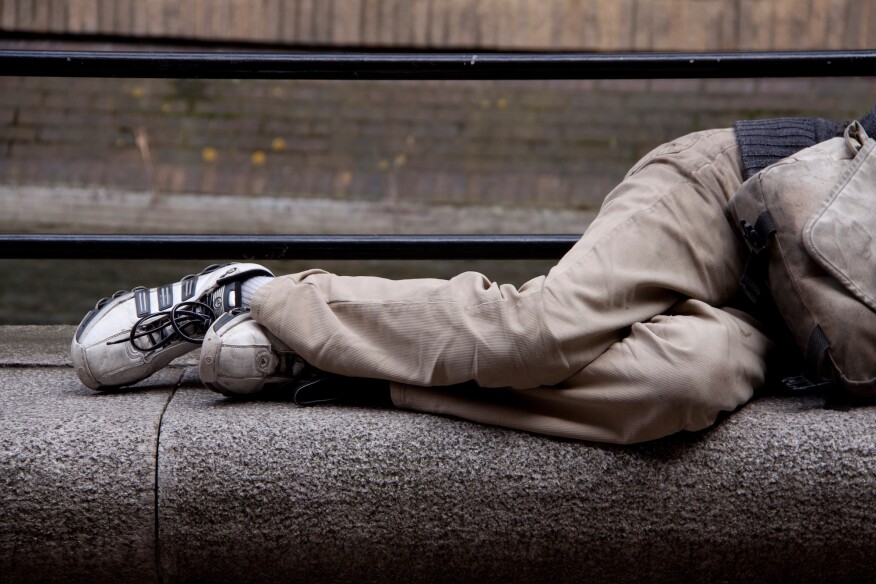
On a single night in January 2022, 582,462 people were experiencing homelessness, according to the Department of Housing and Urban Development’s (HUD’s) Annual Homelessness Assessment Report (AHAR), produced by Abt Associates. This year’s data from the point-in-time count shows only a slight increase—0.3%—over the number of people experiencing homelessness in 2020, the last data set prior to the COVID-19 pandemic.
The data shows an increase of nearly 2,000 people since 2020, during a time when the pandemic and its economic impacts as well as the nation’s affordable housing shortage could have led to more significant increases.
Of the people experiencing homelessness on a single night in January, 384,630 were sheltered and 233,832 were unsheltered, living on the streets, in abandoned buildings, or in other uninhabitable locations.
While the number of people staying in sheltered locations was 2% lower in 2022 than in 2020, the numbers increased this year significantly for individuals, people with disabilities who experience long-term homelessness, and people in unsheltered settings.
According to the report, the number of people unsheltered increased by 3.4% over 2020. Single individuals who are not part of family households continue to represent the largest group of those experiencing homelessness, increasing by 3.1% in 2022, and the number of chronically homeless individuals with disabilities increased 15.6% from 2020 to 2022.
Several groups that benefited from pandemic relief measures and federal homelessness investments saw numbers drop. The number of homeless families with children decreased 6.1% over 2020, while the number of homeless youth decreased by 12%. In addition, the number of veterans dropped by 11.1%; this also marks a 55% drop from 2009 when the data was first reported.
“HUD and everyone in the Biden-Harris administration is committed to ensuring every person has a safe, stable place to call home. Data shows that homelessness remains a national crisis, but it also shows that the historic investments this administration has made to address this issue can work,” said HUD secretary Marcia L. Fudge. “The Biden-Harris administration is working to significantly reduce homelessness across the country and combat the racial and ethnic disparities resulting from system racism.”
The report noted that there continues to be overrepresentation among people of color. While people who identify as Black comprise 12% of the U.S. population, they make up 37% of people experiencing homelessness. People identifying as Hispanic or Latino who were homeless increased by 8% from 2020 to 2022. The number of people identifying as American Indian, Alaska Native, or indigenous who were homeless increased by 4%, while Native Hawaiians or Pacific Islanders saw a 19% jump.
“We’ve made progress with veterans and families with children, but marginalized populations, such as people of color, continue to be dramatically overrepresented, telling us where we need to provide extra support,” said Meghan Henry, Abt’s project director and senior associate. “Additionally, the AHAR and other data shows that people experiencing homelessness are increasingly vulnerable, with growing rates of disability and longer stays in shelters. The 2021 AHAR part-two report, coming in mid-2023, will provide more information on this concerning trend.”
The Biden-Harris administration also addressed the latest numbers by releasing a federal plan for ending homelessness, starting with a goal of a 25% reduction by 2025. The U.S Interagency Council on Homelessness’ (USICH’s) “All In: The Federal Strategic Plan to Prevent and End Homelessness” recommits the federal government to strategies that have been proven to work, such as the Housing First model.
“My plan offers a road map for not only getting people into housing but also ensuring that they have access to the support, services, and income that allow them to thrive,” President Joe Biden said in a statement, encouraging state and local governments to use the plan as a blueprint for their own goals. “It is a plan that is grounded in the best evidence and aims to improve equity and strengthen collaboration at all levels.”
The White House and the USICH also announced an initiative to helps cities and states reduce unsheltered homelessness, with the 19 federal agencies part of the USICH working with local governments to accelerate the implementation of strategies to get people into homes.
“Housing should be treated as a human right,” said USICH executive director Jeff Olivet. “Many Americans ask, ‘Is it possible to end homelessness?’ The answer is yes, the United States can end homelessness by fixing systems—not by blaming the people being failed by them. With “All In,” the Biden-Harris administration outlined a set of strategies and actions for doing just that. Now we must scale what works and develop new and creative solutions to build a future where no one experiences the tragedy and indignity of homelessness—and everyone has a safe, stable, accessible, and affordable home.”
National Alliance to End Homelessness CEO Ann Oliva added that this year’s report shows that the United States knows how to end homelessness.
“As emergency COVID relief measures expire, we will need federal, state, and local leaders to step up with investments to maintain and build upon this progress,” she said. “The Alliance is encouraged that the commitments outlined in USICH’s Federal Strategic Plan set ambitious goals and acknowledge the government’s essential role in advancing best practices for ending homelessness. This is fundamental for turning the tide on the crisis of homelessness in America.”










